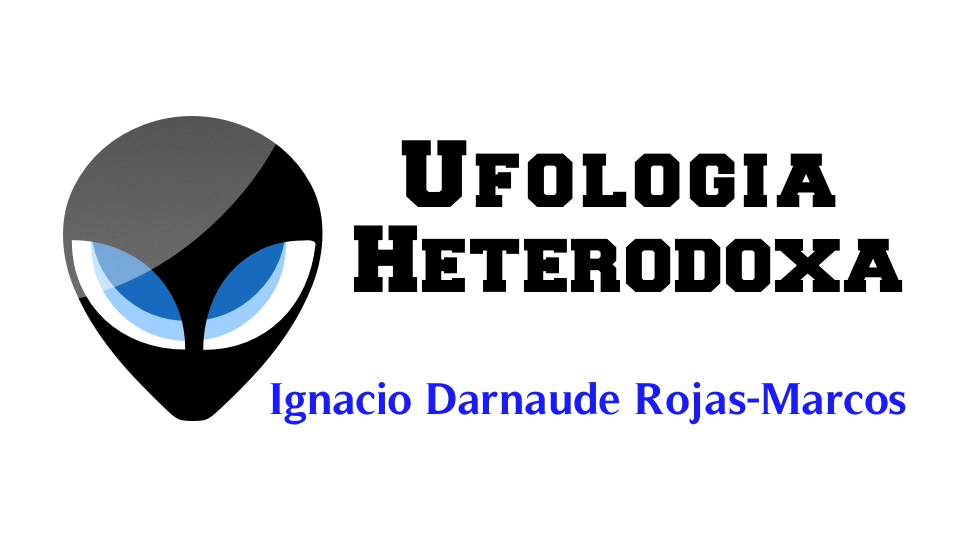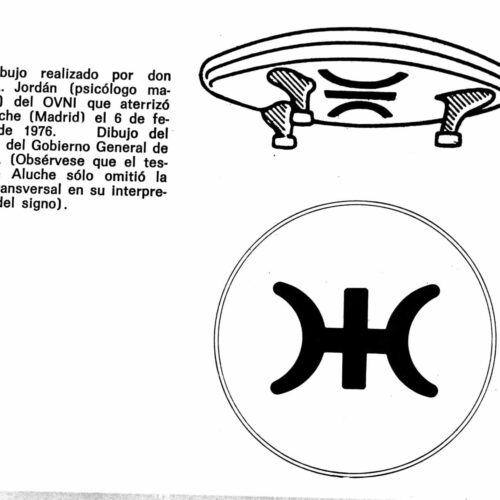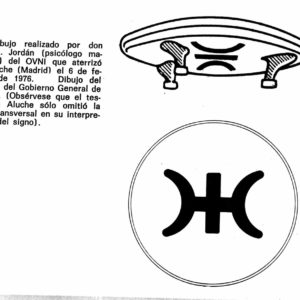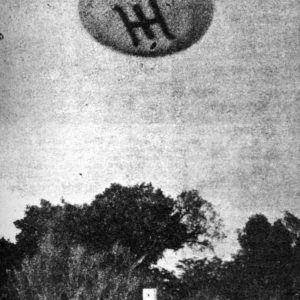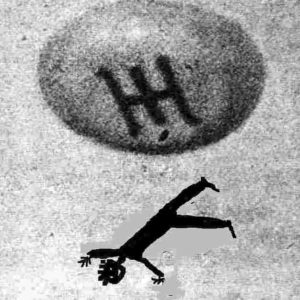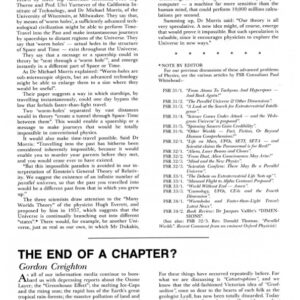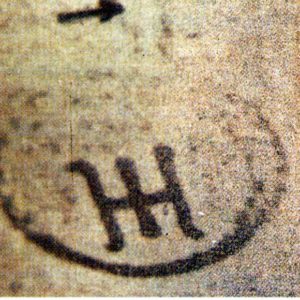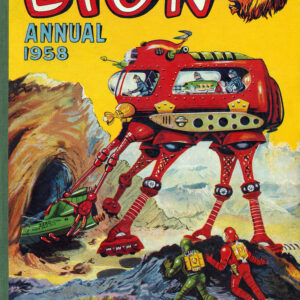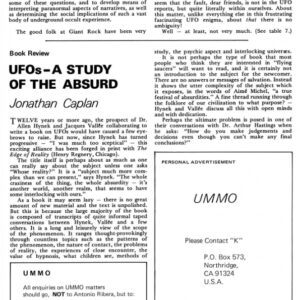Wolf-424 Estrella Ummo por Overmeire
- Descripción
Descripción
Wolf-424 Estrella Ummo por Overmeire
Godelieve Van Overmeire
WOLF – 424 : THE PLANET UMMO STAR
IS WOLF-424 THE UMMO STAR IUMMA ?
An Ummite document claims Yumma, the central star of the Ummo system, to be Wolf 424. The Hubble Space Telescope studied this star and allowed the Ufocom to check this Ummite assertion.
The data
For the first time the HST imaged the double star Wolf 424 AB -14.3 light-years away- of which both components are supposed to be black dwarfs of nearly equal magnitude. The visual magnitude (that is from Earth) of the couple is about 12.5, so they are visible with a small telescope, but the components are less than 0.5″ apart, thus the HST was necessary to efficiently distinguish between them. They seem to orbit about 2 AU apart (astronomical unit: Sun-Earth distance), 300 millions kilometres. The total mass is 14.2% of the Sun’s.
Birth of a star
What is a black dwarf? To summarise, it is an unfinished proto-star. The large hydrogen clouds in galaxies sometimes become gravitationally unstable, and then collapse. Matter collapses up to such an extent that central temperature and pressure can start nuclear reactions. Meanwhile, a small part of the peripheral cloud stays in stable orbits, where the components slowly clamp. Asteroids and comets finally get formed if there is enough matter.
Black dwarfs
One can easily imagine that if the mass of the initial gas cloud is small, the central gravitational pressure will be too weak to light nuclear reactions and you get a hot gas sphere: a black dwarf. «Hot», but in fact very cold compared to a real star: a kind of big Jupiter.
In such a condition, the little matter remaining in the false-star orbit is not able to create planets. The cloud residue stays as a cloud. There is probably grain formation, maybe asteroids, but no more. Anyway if a planet were formed, it would be very small, and surely not capable of holding an atmosphere because of the small gravity. Moreover, such a cold «star» would certainly not support life. Furthermore, this is a double star, which has components rotating around each other. That would imply a planet with a very complex orbit having both close and far positions compared to the stars, with enormous climatic variations on the surface, surely not favourable for life.
Letter information
Effectively the letters announce a «cold» star, but never say about a double star. According to these letters, Ummo is bigger than Earth. Nevertheless, Earth must already be a «big» planet: it is the biggest non-gaseous one in the Solar System. Thus it seems difficult to imagine a bigger body around such a light star system. These letters also state that Ummo orbits in an ellipse of 0.07833 eccentricity (almost a circle), in 3.8 years. Thus there is another problem: A planet running around two similar stars can not have an elliptic orbit, but its movement would look like a chaotic trajectory. If the planet were far away from the couple (thus very cold), or at the contrary very close to one of the stars (very hot!), the orbit could *look* like an ellipse (but we have a five decimal-precision value!). Nevertheless, in both cases, the year would be very different of 3.8 years.
Conclusion
Even without taking into account the contradictions with the letter information, this quick analysis points out that if the Ummo planet exists, it does surely not orbit around Wolf 424. The Ummites have always been confusing us, mixing up information an lie…
Fabrice, UFOCOM «SCI» COORD.
This article was found on UFOCOM (our thanks)
Wol f- 424 a b
The star we assumed to be IUMMA, hosting the planet UMMO appears to be a brown dwarf, in other words an object less massive than a hydrogen burning star, but more massive than the planet Jupiter. It does not seem to be an enjoyable place for an inhabited planet!
HUBBLE SPACE TELESCOPE RESOLVES BROWN-DWARF BINARY STAR
For the first time, NASA’s Hubble Space Telescope has successfully imaged the candidate brown-dwarf binary system Wolf 424 AB. Both stars of this system are brown-dwarf candidates. The dynamical mass estimates are based on orbital elements derived from photographic and visual mircometer observations spanning fifty years. Wolf 424 AB is at a distance of 14.0 lightyears and is considered a nearby neighbor to the sun.
The images from HST have resolved this binary star system into two components, allowing the measurement of the separation between the primary and companion stars. This small distance and position angle, when combined with ground-based photographic astrometric measurements and infrared speckle imaging, can be used to constrain the combined mass of the system.
These observations using the high resolution provided by HST in combination with the Faint Object Spectrograph (FOS), were made by a team of scientists from Computer Sciences Corporation (Dr. Alfred Schultz, Dr. Helen Hart, Forrest Hamilton, & Mark Kochte), Catholic University (Fred Bruhweiler), McDonald Observatory (Fritz Benedict), York University (John Caldwell & Cindy Cunningham), Lowell Observatory (Otto Franz), STScI (Tony Keyes), and Univ. of Colorado (Jack Brandt). These images resolve the binary system into separate components, a feat previously only preformed in 1991 from the ground with infrared speckle imaging. At that time, the companion was at a distance of 0.436 arcsecond from the primary star, while at the time of the HST observations, the companion had passed periastron (closest approach to primary star) and was at a separation distance of 0.41 arcsecond.
The resolving power obtained with the FOS image is comparable to separating the two headlights on an automobile (approximately 5 ft between headlights) at a distance of 160 miles. The image was obtained without any filter, thereby imaging the star with the entire visual light band, from blue to red. The two stars have nearly equal brightness. The combined magnitude of the pair is V ~12.5. The star system is in the northern sky. It cannot be resolved from the ground except with a very large telescope. A «light year» is the distance light, traveling at a speed of 186,000 miles/second, would transverse in a year. If one viewed the earth from a distance of 3.26 lightyears, the maximum separation between the earth and the sun (1 AU) would be «1 arcsecond.» The double quote symbol following a number represents units of arcseconds. An AU (astronomical unit) is the distance from the earth to the sun (92 million miles). It takes 8 minutes for the light from the sun to reach the earth.
A coronagraphic type instrument is needed to block out the bright light coming from the primary star to be able to image the light from a companion star. A coronagraph is a device with an occulting spot, finger, or bar in the optical path that blocks the light from a star (or the sun) from reaching the detector. The FOS, though not considered an imaging camera, does have a coronagraphic capability with the large barred aperture. The large barred aperture is 1.7″ square with a 0.27″ wide bar across the center of the aperture. In addition, the FOS is the only HST instrument with a demonstrated on-board capability to position a star behind the occulting bar. This is the so-called PEAK-DOWN target acquisition capability. The large barred aperture was designed so that an object could be centered behind the bar and spectra obtained from each opening of the aperture.
Once the HST FOS images were obtained, sophisticated computer processing was required to «deconvolve» the images to reveal the faint companion. An FOS ACQIMAGE is created when the FOS camera mirror images the aperture onto the photocathode, which produces photoelectrons that are deflected onto the Digicon for readout. The Digicon detector is an array of 512 rectangular shaped diodes. The shape of the mapping diodes combined with the x- and y-stepping of the mirror scan transforms a star image into a rectangular shape. A star image is sampled 4 times in x and 20 times in y.
A computer software program based on a Fourier transform was used to deconvolve the ACQIMAGE into the images displayed in the photograph. Wolf 424 AB was imaged centered behind the occulting bar (coronagraphic mode) and with the occulting bar rotated out of the field of view. In the coronagraphic image, the bar covers both stars. This allows for a far longer exposure to be taken (200.0 seconds; without the bar, only 20 seconds) to probe for faint companions. The bar causes the dark band across the image of the stars. Portions of the star image extend beyond both edges of the bar. It was expected from previous orbital elements that the companion star would not be covered by the bar. The FOS coronagraphic image indicates the orbital elements need to be revised. The dynamical mass of a star (or brown dwarf) can only be determined if it is a member of a binary system. The total mass of the binary system and individual masses can be constrained once the relative orbit has been determined from high angular resolution observations. Orbital periods for binary systems can range from minutes, hours, days, years, and up to hundreds of years for large separations between the two components.
Ground-based astrometric measurements are usually based on many years of observations with photographic plates. Often, the components of a binary system are not resolved, but the combined light is imaged as an oval. Direct imaging of a binary system, resolving the components into separate images, is the preferred method for determining the orbit parameters. For close faint companions, performing this task from the ground is difficult. The FOS images of Wolf 424 AB, a known candidate brown-dwarf pair, shows the companion is not following the predicted orbit.
The updated orbital elements yield a total mass estimate for the pair of ~0.142 solar, which is larger than the previous mass estimate of ~0.110 solar derived using photographic astrometry, but smaller than the mass estimate of ~0.25 solar derived from infrared speckle imaging. The revised orbit, including the FOS position of the companion, does not rule out the possibility that the component masses, or at least Wolf 424 B, are substellar and within the realm of brown dwarfs. Astronomers are excited about discovering and studying brown dwarfs. Brown dwarfs are objects that are less massive than a hydrogen burning star, but more massive than the planet Jupiter. Brown dwarfs bridge the gap between the formation of stars and the formation of planets. The HST FOS imaging technique discussed above is being used to image the nearby stars in search of brown dwarfs. Four targets have been imaged to date, Wolf 359, Wolf 424 AB, GJ 1245 AC and Gl 293
Comparison with Ground-based View
Two nearby stars Wolf 359 (red dwarf, distance 7.5 light years) and Wolf 424 AB (red dwarf binary system, distance 14 light years) have been imaged with the Faint Object Spectrograph detector in ACQIMAGE mode. Wolf 359 (Visual magnitude of 13.4) is the third closest star system to the Sun. It is also famous in Star Trek lore as the location where the Borg defeated Star Fleet. No faint companion was found about Wolf 359. The two components of the Wolf 424 AB (combined Visual magnitude 12.5) binary system have been resolved in the FOS ACQIMAGE. The HST observation yields a separation of 0.4 arcseconds between the two components. Comparison with a predicted orbit (Heintz 1989) indicates the component masses are larger than the previous estimate.
However, Wolf 424 B has a probable mass lower than the brown dwarf cutoff of 0.08 solar mass, below which nuclear fusion cannot occur.
Source :
http://scivax.stsci.edu/~kochte/wolf-page.html and http://scivax.stsci.edu/~kochte/wolf424-results.html
Image files in GIF and JPEG format are available via World Wide Wed from URL http://www.stsci.edu/pubinfo/PR/96/aas96sum.html
******************************************************
WOLF – 424 b, c
[ Antecedentes Descubrimiento ] [ Mapa Posicional ] [ Parámetros Estelares ] [ Comparaciones con el Sistema Solar ]
ACTUALIZADO:
el 10 de enero de 1998.-
Durante el año 1996, se fueron descubriendo nuevas estrellas enanas café o marrones. Un equipo compuesto por Alfred Schutz y Helen Hart de la Corporación de Ciencias Computacionales, mientras evaluaban el trabajo de observaciones hechas por el Telescopio Espacial Habble, encontraron claros indicios sobre la existencia de dos enanas café orbitando a la estrella Wolf 424 ubicada a catorce años luz de la Tierra. Imágenes tomadas para estudiar la estrella revelaron la presencia de dos objetos orbitándola. En las primeras tomas de la observación, no existía claridad para definir la clase de objetos que se distinguían como compañeros de la estrella; sin embargo, tomas posteriores han entregado antecedentes sólidos como para poder determinar de que se trataría de objetos que en su conjunto sumarían aproximadamente entre 0,14 y 0,20 masas solares, siendo el que fue designado provisoriamente con la letra b un trece por ciento más masivo que su compañero señalado con la letra c. A menos que los dos compañeros de la estrella de la referencia se encuentren cerca del limite de masa que se ha determinado como viable para estrellas, Wolf 424c reuniría todas las características que se han diseñado para las estrellas enanas café o marrones. O sea, que este cuerpo no tendría masa suficiente como para quemar hidrógeno en su núcleo. Pero también existe la posibilidad de que ambos compañeros de la estrella madre sean enanas café, pero para poder concluir eso, es necesario una mayor cantidad de observaciones a realizar por el telescopio Habble.
*
__________________________________
ANTECEDENTES DESCUBRIMIENTO
ESTRELLA: Wolf – 424
OBJETO: Estrella enana café o marrón
SISTEMA : Binario
DESCUBRIDORES : Alfred Schutz y Helen Hart
MÉTODO : HST
FECHA : año 1996.
MAPA POSICIONAL
No se encuentra disponible.
PARÁMETROS ESTELARES
No se encuentra disponible
COMPARACIÓN CON EL SISTEMA SOLAR
No se encuentra disponible.
ANTERIOR — SIGUIENTE
Coronagraphic Imaging of Nearby Stars Comparison with Ground-based View
Two nearby stars Wolf 359 (red dwarf, distance 7.5 light years) and Wolf 424 AB (red dwarf binary system, distance 14 light years) have been imaged with the Faint Object Spectrograph detector in ACQIMAGE mode.
Wolf 359 (Visual magnitude of 13.4) is the third closest star system to the Sun. It is also famous in Star Trek lore as the location where the Borg defeated Star Fleet.
No faint companion was found about Wolf 359.
The two components of the Wolf 424 AB (combined Visual magnitude 12.5) binary system have been resolved in the FOS ACQIMAGE. The HST observation yields a separation of 0.4 arcseconds between the two components. Comparison with a predicted orbit (Heintz 1989) indicates the component masses are larger than the previous estimate. However, Wolf 424 B has a probable mass lower than the brown dwarf cutoff of 0.08 solar mass, below which nuclear fusion cannot occur.
[Left] Photographs showing sky surrounding targets, extracted from digital scan archive data of the Guide Star Selection System. The cross on the GSSS image represents the position of the target star at the EPOCH of the HST observation demonstrating there is no other star in the vicinity at that time.
[Middle] Short 20 second exposure FOS ACQIMAGEs of the targets. The target stars were observed with the 3.7 arcsecond square aperture. The obvious choppy smearing of targets in the vertical direction within each deconvolved ACQIMAGE, as well as the noisy appearance of the point sources, is due to ringing from the image edges in the Fourier transform used to remove the rectangular nature of the FOS diodes.
[Right] Long exposure FOS ACQIMAGEs of the targets while centered behind the 0.27 arcsecond bar of the 2.0-BAR aperture. The 2.0-BAR aperture is 1.71 arcsecond square, with the bar across the center of the aperture. A PEAK-DOWN target acquisition with the mirror was used to center the targets behind the bar. The dark band in the center of each image is caused by the occulting bar in the FOS aperture. In the Wolf 424 AB image (200 seconds), the occulting bar covers both stars, while in the Wolf 359 image (1,600 seconds), the bar covers a single star. The deconvolved images demonstrate that the stars were centered behind the bar. They show it is possible to image two stars of equal brightness as close as 0.16 arcsecond. The FOS ACQIMAGE scale is 0.08 arcseconds/pixel.
HST FOS Imaging Team: A. Schultz, H. Hart, F. Hamilton, M. Kochte (Computer Sciences Corporation), F. Bruhweiler (Catholic U.), G.F. Benedict (U. Texas), J.J. Caldwell, C.C. Cunningham (York University), O.G. Franz (Lowell Obs.), C.D. Keyes (STScI), J.C. Brandt (U. Colo.)
Image files in GIF and JPEG format are available via World Wide Wed from URL
http://www.stsci.edu/pubinfo/PR/96/aas96sum.html
——————————————————————————–
Individual Wolf 424 results
Individual Wolf 359 results
——————————————————————————–
Return to:
Our Low-Mass Companions Page or
Indy’s Home Page
——————————————————————————–
updated 02/20/97 – Mk
kochte@stsci.edu
Matt Allen
Left school in 1988 and decided to be an art student at a local technical college, as it was indoor work with no heavy lifting. For several years he studied several areas of art and the more important skills of seeing how fast you can drink a pint of beer and how many beers does it take to make you honk up! Then he found out he could study a media related course and switched over and never looked back. After leaving College he worked for a London Firm who made multi-media productions for the Film and Video Industry and was responsable for making video trailers for Terminator 2 and Basic Instinct to mention but two.
While working as a video editor he noticed that the very first 3D packages were starting to become availible for home users and after several years of getting really bored of video editing jumped in at the deep end and bought a PC and 3D Studio R3. After much wailing and nashing of teeth he managed to teach himself the basic’s of 3D production and animation. Around this point he joined Compuserve and found that no-one was making Star Trek based pictures or meshes and being a closet SF fan he felt that someone should really be having some fun with 3D Studio. Around this time he and Eric Peterson started to converse and several pictures Matt made with Eric’s meshes impressed Eric enough to start sharing more meshes with Matt. The rest is history with Eric and Matt being the most downloaded SF fan artists on the internet with around 60,000 downloads of the their artwork on Compuserve and AOL alone.
Now Matt works as a freelance 3D artist, and has possible the best collection of SF meshes in the world having swapped meshes with many of the worlds best SF fan artists and as usual Matt always goes in and re-mapps and materials what ever he sent. He has also been making commercial websites for 3 years and made both the original ill-fated Wolf359 on compuserve and then the rather more popular Wolf359 on AOL and now the new Wolf359 2.
Matt spends his spare time anwsering mail from Wolf359, building Wolf359 and upgrading the materials mapps and lighting of any SF mesh he can get his grubby little hands on. Takes great pride at being extremley crap at any game on the Playstation. Eating huge amounts of KFC. And listening to movie soundtracks by the likes of John Williams, Jerry Goldsmith, James Horner and many more.
Currently you’ll find him down the pub every friday drinking weak beer and being socialble as hell, and moaning about how difficult it really is to give up smoking.
Eric Peterson
Garduated magna cum laude from Lehigh University earning his B.S. in engineering mechanics (emphasis on mathematics and numerical methods). A cum laude graduate of the University of Utah, he earned his M.S. in electrical engineering (emphasis on robotic control and simulation). Eric was Chief Mechanical Design Engineer for the Automated Wire Harness Assembly System (featured in October/November 1994 issue of Assembly magazine), and Chief Mechanical Design Engineer for a 12-degree-of-freedom Compact Painting Robot for an aerospace manufacturer, designing the chassis of the 15-ton Robotic Paint Stripping System for Warner Robin Airforce Base (featured in the Aviation Week and Space Technology), and the High Speed Circuit Die Placement System for a super computer manufacturer. As principal engineer for Engineering Spectrum, he designed custom automation equipment for the automotive, aerospace and semiconductor industries.
Eric is the owner of Sisyphus Graphics, which provides commercial, technical and forensic animation contacting services. As technical Director, Sisyphus Software, he developed algorithms for 3D Studio and 3D Studio MAX plug-ins. He and his wife Audrey, a software engineer responsible for code design and construction while he concentrates on the algorithmic and interface design, worked as consultants to Yost Group, assisting in the development of MAX 2.
Mateen Greenway
Left school in 1977 to study Social Psychology at University. Started in computing by taking a couple of computer courses mainly to win a bet and because he always wanted to be like Mr. Spock. Finally spent more that seven years at university as a free lance layabout occaisionally working and collecting various bits of paper. Financed his dissolute lifestyle by doing free lance conputing work and teaching computing to social sciences at various summer schools. Finally decided that he was bored having no money all the time and that accomadation shouldn’t always be cold and/or damp.
Finally decided to look for a job at abot ten o’clock one June morning. There was a knock on the door and there was someone he’d met once offering a job teaching computer studies at a local school. Spent a year doing this before deciding that he didn’t enjoy it very much so he actually went out to find a job.
Was employed by Unilever Computer Services Ltd as a programmer. UCSL was purchased by the US firm EDS after about six months and he has been with them ever since rising to the role of Consultant Systems Engineer. Having worked in several countries including the US, Holland and Germany during this time.
Started getting interested in 3D Graphics as a way of compensating for his complete inablitity to draw. His 3D work really took off when he was working in Germany for six months and had nothing else to do in the evenings. Around about this time he began posting rendered images to the Compuserve Sci-Fi forums and met Matt and Eric. From there it was a short step to getting involved with the Wolfpack.
Suffers from an addiction to collecting 3D meshes and cannot resist building new ones at even the slightest provocation. Likes watching videos rather than tv programs and listening to Terry Practchett books on tape while driving (which drives my wife mad).Still does a lot of travelling for work mainly to places like Detroit, Frankfurt, Luton and occaisionally Paris.
Geo W Proctor
Blame it on Tom Corbett Space Cadet and Wernher von Braun–I want to be a spaceman when I grow up. I met both of them at age six in 1953 on early television. Along the way I met Flash Gordon, Buck Rogers, Commando Cody, Captain Midnight, Edgar Rice Burroughs, Edgar Allen Poe, Robert Bloch, H. P. Lovecraft, Robert Heinlein, Arthur C. Clarke, Mark Twain, Robert Silverberg, Fritz Leiber, Dashiell Hammett, Robert E. Howard, Chesley Bonestell, Jack Kirby, Steve Ditko, Wally Wood, Al Williamson, Frank Frazetta, Kelly Freas, Jack Gaughn–and endless list who all threw in their two cents worth via movies, television, the printed word, paintings, and comic books. So while I await to take my place on the deck of a vessel sailing to the stars, I find myself a writer by trade.
That profession has transformed me into a time traveler, having produced novels of humankind’s far future and those of the American West. Not at all bad, at least the way I see it, for a native Texan who graduated from Texas Tech University in 1969 with a degree in journalism and minor in government.
I also doodle, which led to painting, and finally discovering computer modeling and rendering in late 1995, which is why I’m writing this and you are reading it. Via email, I fell into this group of Star Trek fans and started exchanging models and advice and help–mostly they helped me. Why? I don’t know. I don’t even like Star Trek. But I do like the ships and the art these «kids» produce. Plus none of them call me Gramps.
As said at the beginning, I want to be a spaceman when I grow up. So while I wait my call to the gleaming spires of glass and steel at the Space Academy, I live in Arlington, Texas, with Lana, my wife of 28 years, and two cats.
Barry Spikes
Graduated High School 1987. Joined the U.S. Navy as an Aviation Sonar Mate in the Summer of 1987. Was stationed on the U.S.S. Bunker Hill (Cg-52). During this time I got into the computer hardware and software games.
After leaving the U.S. Navy went to a Locate Associate College and got an A.S. Degree in telecommunications and networking in 1992. Started working for Dell Computer Corp. 1992 in Tech Support and have been working for them todate. I would have been with Dell for 5 years.
I have been a SciFi fan for as long as I have can remember. Growing up watching Star Trek reruns on T.V. Lately I have been horsing around with 3ds files and learning about it on my spare time. With the help of Matt Allen and Eric Peterson they have got me going in the right direction.
On my spare time I build 3ds pictures and Beta Test for a major software gaming company.
I enjoy sending time with a very good friend which just starting onto the computer industry.
Going to SciFi movies and horsing around on the Internet. I enjoy building Win 95 Themes and have got good reviews from people around the world of the latest theme. I plan on making more soon. See you on the Internet……….
Martin Hajek
Hajek, Martin Hajek is the name and rendering is my game…I guess. Well, many people think I’m good at doing so and that’s why you’re reading this bio right now! Born in 1975 which is already 22 years behind us I got my first glimpse of Star Trek when I was eight (that’s right, back in 1983), one thing stuck with me ever since…that beautiful ship called ‘Enterprise’ which (expect for the 1701E!) has only gotten prettier over the years…but enough about that.
When I graduated from highschool in 1993 I figured ‘doing’ Industrial Design Engineering at a Dutch university would be best…well, except for the mathematics I still enjoy doing it and hope to graduate before the end of this century! It was in the first year at university that I got hold of 3dstudio (R2) – and I’ve never spent a month without it since, which has enabled me to become as good at modelling as I’m right now! After meeting Matt Allen and subsequently joining the Wolfpak my skills have -hopefully- only improved so expect many more great things to happen in the future!
‘Is Star Trek and rendering all there is in your live?’ I hear you ask, well, uhm, not completely. I really like watching a bit of Formula 1 racing and am an avid Soundtrack-collector (you know, that’s the kind of music that goes with the movies…or is itthe other way round?) and last-but-not-least, I’m an editor of the one-and-only dutch Sci-Fi magazine «SF Report» (buy it now! 😉 On a personal note; I don’t drink anything containing alcohol (‘Is he crazy!?’ I hear Matt say), I like cats, no girlfriend…well, I guess that about sums me up! 🙂 Silly me, forgot to tell you (but if you’ve paid attention you already know) -I live in Holland.
Jeorge Gerlach
I was born on October 31st in 1975 in Karl-Marx-Stadt (now re-renamed in Chemnitz). I made until 1994 my highschool and so I had access to any university. But before starting my studies I first had to go a year in the army. I was commanded to the rocket artillery and there I was the guy who sat the whole day in a little office and wrote some stuff. Very relaxing…
After that year I tried to study a year law to become one fine day an over-payed lawyer. But that stuff wasn’t the right for me. So I decided to try it with economics and business at the Technical University of Chemnitz. That’s what I’m doing right now, hope it works this time better.
Except studying I’m an excessive user of my computer, a lot of time I’m spending with creating new models and images of all and everything, especially StarTrek models.
Steve Ranson
Coming soon!
All the 3D Stills and graphics contained on this site are copyright of the 3D Stills Team and the Wolfpak 1995/1996/1997.
Graphics on this page and the following pages are copyright of the the wolfpak and are used with permission.
DO NOT USE WITHOUT WRITTEN PERMISSION!
************************************************************************************************************************************************************************************************
©
INFORMACIÓN EN EL ARCHIVO DE MADAME GODELIEVE VAN OVERMEIRE ( BRUSELAS , BÉLGICA ).
Documents from the private files of
Madame Godelieve Van Overmeire
( Brussels , Belgium )
